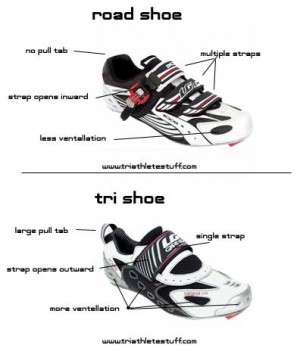Triathlon Vs Road Shoes
 When beginning in the cycling community there is much debate as to whether one should purchase triathlon or road shoes. Each of these shoes has their advantages as well as disadvantages. Depending on what needs you have, you may use the following factors to help you determine which cycling shoe is the most appropriate for training or racing.
When beginning in the cycling community there is much debate as to whether one should purchase triathlon or road shoes. Each of these shoes has their advantages as well as disadvantages. Depending on what needs you have, you may use the following factors to help you determine which cycling shoe is the most appropriate for training or racing.
Transition
If you participate in triathlons regularly then there are a few advantages of having triathlon shoes versus road shoes. Due to the ease of having one or two Velcro straps, triathlon shoes are a lot easier to slide on and off; with these, you don’t have to worry about any buckles or adjustments. This can come in handy during your swim to bike transition, in which you can clip the shoes on your bike, run barefoot through transition, and slide into your shoes once you’re on the bike. However, if you don’t feel comfortable with doing a flying dismount during your next triathlon, and prefer putting on your shoes before mounting your bike, triathlon shoes are easier to put on. Although, the seconds lost putting on triathlon shoes versus road shoes is minimal. Moreover, triathlon shoes also carry the advantage that they’re seamless and don’t require socks therefore minimizing blisters.
Pedal Stroke
Of all the factors distinguishing these two shoes, the advantage of an improved pedal stroke is my personal favorite. Prior to switching to road shoes, I would ride in Shimano WT-52 shoes, which were great for comfort and learning ease in transition. However, I was beginning to get a lot of stress on my IT band as well as toe numbness on longer rides. After a year of making minor adjustments with no resolve I decided to make the switch to road shoes. What a difference it made!
Road shoes have less lateral gliding motion on the clips, which prevents stress on your hip abductor muscles such as the TFL which tapers into the IT band. I no longer felt that nagging pain during my longer rides or numbness in my toes. Also, road shoes tend to be narrower than triathlon shoes and this fit aids with a more efficient pedal stroke. Due to the fit and minimal glide movement, it allows for increased efficiency which translates to more power on the bike. I’ve definitely noticed an improvement in riding comfort and power with my road shoes, especially on rides greater than 35 miles. Therefore, losing a few seconds in transition doesn’t compare to the overall effects experienced during the bike leg of a triathlon.
Cost
The cost between these two types of shoes depends on the brand, model year, and size (if purchasing online). However, most of the time triathlon shoes tend to more expensive than road shoes. A way to deter these costs is by purchasing an older model that the shop is trying to get rid of to make room for the newer models. In addition, amazon.com has great deals on both triathlon and road shoes (i.e. louis garneu, pearl izumi).
When trying to determine which shoe is the most appropriate option I’d suggest thinking of the following questions: Do you have a wide or narrow foot? Do you train often and have frequent long rides? Are you experiencing pain or discomfort in your foot, patella, or lateral knee? Are you a triathlete who is comfortable with transitioning or still learning? These are the questions you should be asking yourself when purchasing cycling shoes rather than using cost as a determining factor. It is better to have a comfortable fit that is conducive to your cycling regime, than have cheaper shoes which create more problems for you in the long run.